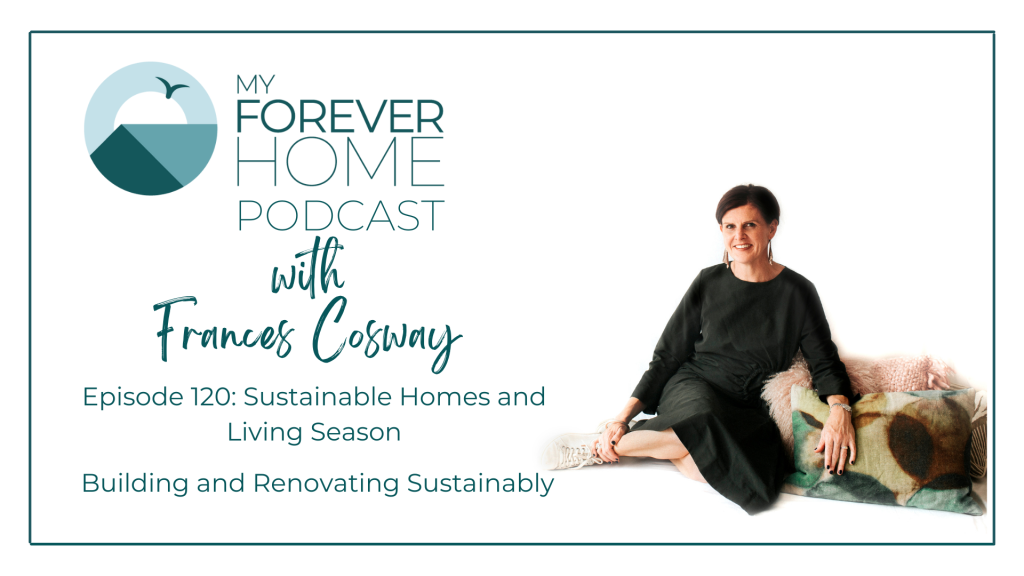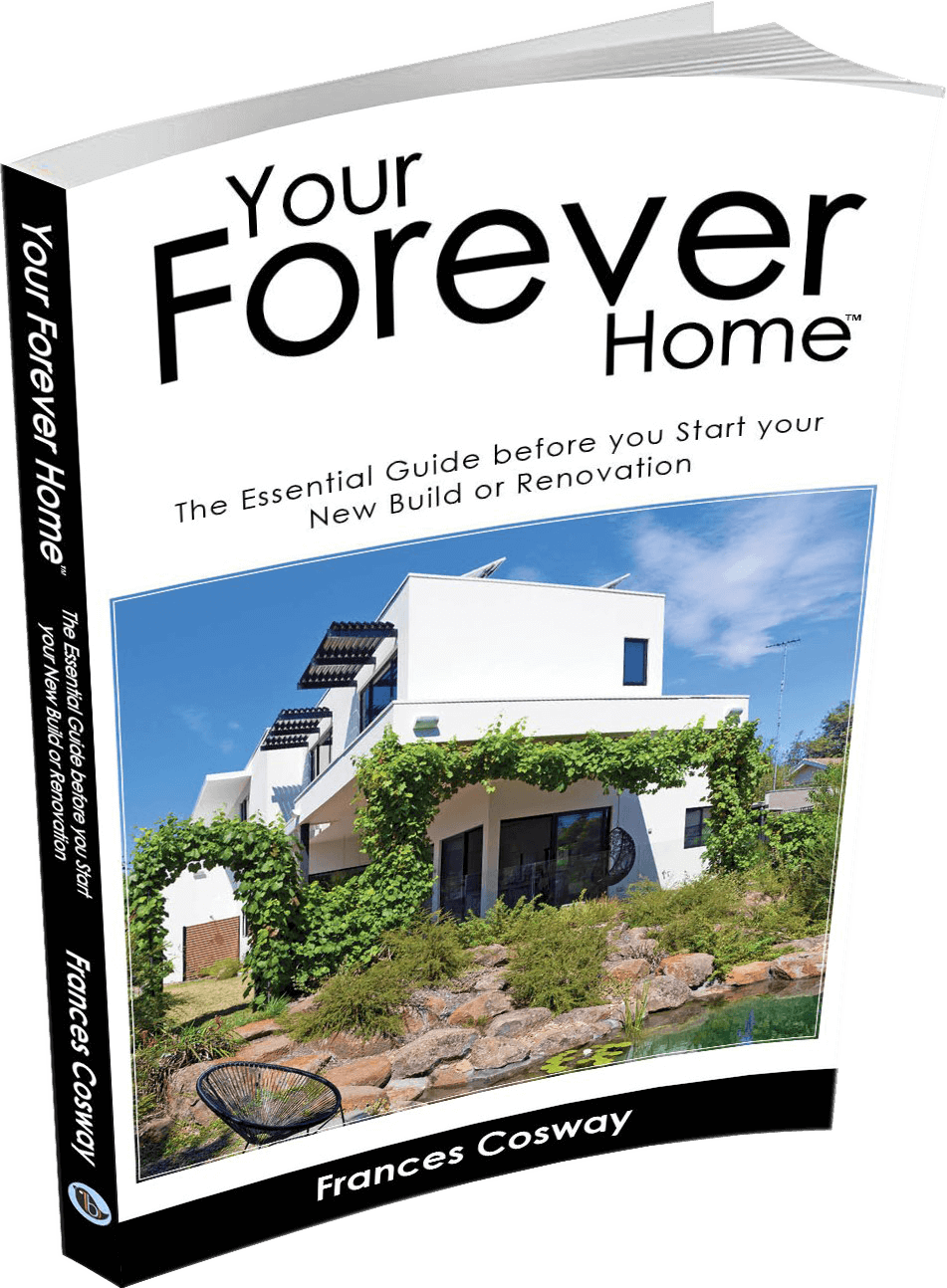In this episode of the podcast Frances welcomes back Jeremy Gates from Gaia Construction to talk all things building and renovating sustainably. Jeremy highlights his top 5 ways that you can make your home more energy efficient, along with how to choose a sustainable builder. He discusses passive house principles that can be used to create a more comfortable home and mistakes to avoid.
E120 – Building and Renovating Sustainably – Sustainable Homes and Living Season E10

SHOWNOTES
Guest: Jeremy Gates from Gaia Construction
Jeremy is a qualified passive house tradesperson and the Managing Director of Gaia Construction. Their mission is to improve the lives of homeowners in bayside suburbs at Melbourne by building exceptional homes and providing an enjoyable building experience.
Jeremy is a registered Green Living Builder, an Energy Smart Builder and a Certified Passive House Tradesperson. With his expertise and experience in building highly energy efficient homes, Jeremy is able to provide informed and practical advice on sustainable materials and options for improving energy efficiency to all of his clients.
Key areas of importance when building a sustainable home (what you shouldn’t skimp on)
- Finding the right team to work with – all will have knowledge of sustainable products and practices, the whole team should work together to give you different design options and the pros and cons (Ie SIPS VRs Stick built) and their costs
-
- Architect
- Builder
- Engineer
- Interior designer
- Orientation (Sometimes you cannot get the perfect orientation as you want views)
- External Shading
Areas to focus on when renovating to improve the energy efficiency:
- Roof insulation
- Wall insulation (this could be internal or external)
- Filling any gaps
- Window shading
- Double glazing
Common mistakes when wanting to create an more energy efficient home
- Designing a home that is too big.
- Designing a house that is over the budget if the budget is tight (this is why you need a team and not rely solely on the architect to keep to your budget!)
- Engaging a builder who does not care/know about the energy efficiency of the home
- Installing the wrong insulation – too much insulation by not filling gaps around windows. It creates condensation and mould and sick house syndrome
- For example: if you do not have a vapour barrier in your wall, filling it with the wrong insulation will allow mould to grow which is really bad for your health and the health of the home)
Need to ask yourself;-
- Why you want to build what you want to build
- Lower bills in the future
- A healthier home (if asthma is an issue, a passive house is great).
- Build with recyclable materials
- What you are looking to build
- A new passive house or renovation
- An energy efficient home
- Just to make existing home more comfortable
- If renovation – Understanding how existing house performs and what is achievable in the budget
- Finding out your budget and then getting advice on the most bang for your dollar
- Having the knowledge and being passionate about delivering an energy efficient home
How to find and choose a sustainable builder
- Look on the passive house web site
- Look under Green Building Institute
- Look Green Living Master builders
- Do some research on google and speak to previous clients
Does building sustainably cost significantly more?
If you are building a medium to high spec home, the cost difference is not that much. You cannot compare it to a volume build home because they are two completely different products.
Cost of building a passive house (in %) – as at December 2022:
- A little as 5% up to 20%
- Main cost is in insulation $5,000 $10,000.
- Windows can be a lot more expensive $10, 000- $100,000 depending on if they are Australian UPVC or imported specialised windows from overseas.
- Airtightness/wrap will cost an extra $5,000 – $10,000. BUT the heating and cooling with an HRV will cost less and the house may not be as big which will save money.
- Choosing SIPS – for example you can take 8 weeks of a build schedule which can be 8 weeks saving in rent and storage
Passive house or passive solar principles that are most important that people can design and build for, if not building an accredited passive house
- Orientation
- Window Shading (eaves)
- Basic 5, as before
- Roof insulation
- Wall insulation (this could be internal or external)
- Filling any gaps
- Window shading
- Double glazing
- 5 basic principles of a passive house
- Insulation
- Glazing
-
- Airtightness
- HRV
- Thermal bridges
Building materials that make a difference or recommend when people are conscious about building sustainably
- From an interiors perspective, White Pebble suggest Green Tag accredited products and recycled materials – Egger, Paperrock (recycled), Navurban, Dekton (carbon Neutral), Betta Stone (recycled glass)
- If renovating – using materials from the current building
- Recycling bricks, any timber
- Retaining established trees for shade
Holding off building now and waiting until prices come down?
Some material costs have definitely levelled off and come down a bit (like timber). Other materials are predicted to go up in cost (Cement based products, concrete, cement sheet materials,) and these items will equal themselves out.
Due to the building boom, and in Victoria Civil projects like the tunnel which are absorbing a lot of the skilled labour coupled with low migration of skilled labour costs are high due to simple supply and demand.
Costs may not go to back to pre-pandemic levels. If you are working from home and your house is too small or really expensive to heat and cool, it is not going to get any bigger or cheaper to run as gas and electricity prices go up.
If you are interested in building know is the right time to do it!
Advice from Jeremy:
The Victorian government has a good initiative with the Energy Efficiency Scorecard, which is an evaluation of your house and how it performs. They let you know about gaps, windows, and where you’re leaking energy. They will help you make your house more energy efficient.
Useful Links:
- Gaia Construction – https://gaiaconstruction.com.au/
- Gaia Construction contact number – 9989-0799 (Port Melbourne to Mordialloc, Richmond, Malvern, Malvern East corridor)
- Podcast Episode 32 with Jeremy Gates: Kitchen Design Essentials – The Builder’s Insight – https://www.whitepebbleinteriors.com.au/the-builders-insight/
- The 5 Build Stages – https://www.whitepebbleinteriors.com.au/the-five-building-stages/
- What You Need to Know Before You Build – https://www.whitepebbleinteriors.com.au/what-you-need-to-know-before-you-build/
- The Building Stages and What to Expect – https://www.whitepebbleinteriors.com.au/the-building-stages-and-what-to-expect/
Starting a renovation or new home project and wondering how to get your team together?
Get Free instant access to the “How to Find Your Renovation or New Build Team”. This FREE guide outlines who you need on your team, and how to find them.
Get instant access now by clicking on the link: https://www.whitepebbleinteriors.com.au/findyourrenovationteam/
- Book a chat with me directly – https://www.whitepebbleinteriors.com.au/chat/
- Floorplan Sanity Check™ – https://www.whitepebbleinteriors.com.au/floor-plan-sanity-check-booking-form/
- Access the first three chapters of Your Forever Home for FREE – https://www.whitepebbleinteriors.com.au/download-free-ebook/




